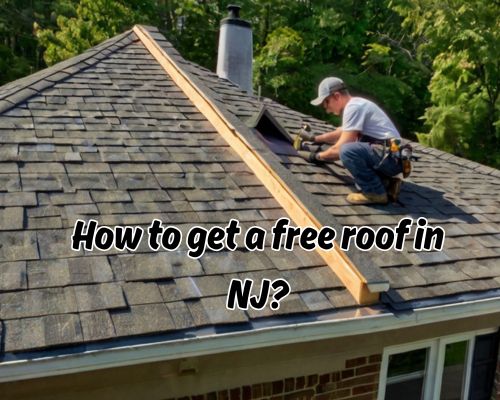When a leaky roof threatens to ruin more than just your peace of mind, and you can’t afford the repairs, you might wonder: how to get a free roof in NJ? Fortunately, New Jersey offers a patchwork of programs—federal, state, and non-profit—that could mean the difference between sleepless nights and a safe, secure home overhead.

In this guide, we’ll unpack everything from government assistance programs and insurance tips to non-profit grants and storm damage support, so you can find the best route to getting a free roof replacement in New Jersey.
1. 💸 Government Roofing Assistance Programs in New Jersey
🏛️ Section 504 Home Repair Program (USDA)
Low-income homeowners in rural New Jersey counties (like Warren, Salem, and Cumberland) may qualify for the USDA’s Section 504 Home Repair program, which offers grants of up to $10,000 for essential repairs—like replacing a dangerous or failing roof.
- Eligibility: Must own and occupy the home, be 62 or older, and fall under income limits.
- Bonus: No repayment required if the grant is used correctly and you remain in the home for three years.
👉 Learn more at the USDA Rural Development NJ website.
🏡 HUD HOME Program & Community Development Block Grants (CDBG)
Many counties and municipalities in New Jersey allocate HUD CDBG funds to help homeowners make roof repairs or replacements. Each local housing authority or county administration sets specific criteria and funding limits.
- Look into programs in Essex County, Camden, Newark, Paterson, or Jersey City, which often have ongoing housing assistance programs.
2. 🛠️ Non-Profit Organizations That Provide Free Roof Repairs in NJ
🧰 Habitat for Humanity New Jersey
While known for building homes, Habitat for Humanity affiliates in New Jersey (such as Morris County Habitat for Humanity or Habitat of Greater Newark) offer critical home repair programs that sometimes cover roof replacement for low-income or elderly homeowners.
- Applications prioritize seniors, veterans, and households with disabled individuals.
🏘️ Rebuilding Together North Jersey & Camden
This national organization has local New Jersey chapters focused on repairing and revitalizing homes for low-income residents. Roofs damaged by water, rot, or age may qualify if deemed a health or safety risk.
- Visit RebuildingTogether.org and search by your zip code for NJ-specific support.
3. 🌪️ Free Roofs After Storms: FEMA & Disaster Assistance
🌀 FEMA Blue Roof Program (in Disaster Zones)
If your roof has been damaged in a declared federal disaster (e.g., from hurricanes or nor’easters affecting NJ counties), you might be eligible for the FEMA Blue Roof Program or direct home repair funding.
- In New Jersey, past qualifying events have included Hurricane Ida, Superstorm Sandy, and severe winter storms.
✅ Apply through DisasterAssistance.gov when a new emergency is declared.
4. 🧾 Roof Replacement Covered by Insurance
If your roof was damaged due to a qualifying event—like hail, wind, or fallen tree limbs—your homeowner’s insurance may cover the full cost of replacement, depending on your policy terms.
✅ Tips to Navigate the Insurance Process in NJ:
- Document damage immediately after a storm (photos, videos, timestamped).
- Contact a licensed NJ roofing contractor for a free inspection and written estimate.
- File a claim promptly with your insurance provider.
- Ask your contractor to work with the adjuster—many NJ roofing companies offer this service.
🧠 Pro Tip: If your roof is over 20 years old, your coverage may be reduced to Actual Cash Value (ACV) rather than full replacement. Be sure to clarify this in your policy.
5. 🔄 Energy & Weatherization Programs That Include Roofing
❄️ LIHEAP (Low Income Home Energy Assistance Program)
While LIHEAP in NJ primarily covers heating costs, it may fund emergency repairs to home systems—including roofs—if they result in energy loss or safety hazards.
🧊 Weatherization Assistance Program (WAP)
This federally-funded program—administered in NJ by the Department of Community Affairs (DCA)—may cover insulation, ventilation, and roof-related repairs for eligible low-income households.
6. 🎯 Local County and City-Based Free Roof Initiatives
Several New Jersey counties offer unique home repair assistance, especially for senior citizens, veterans, and individuals with disabilities.
🧓 Senior and Disabled Repair Programs:
- Union County runs a Home Improvement Program that covers roofing.
- Monmouth ACTS provides home safety improvements, including roofs, for elderly residents.
Always check with your local Department of Housing & Community Development, Community Action Agencies, or NJ Aging Services for county-specific offerings.
7. 🏗️ Churches and Community-Based Roof Support
Faith-based organizations in NJ—including Catholic Charities, Jewish Family Services, and local Baptist missions—sometimes offer one-time grants or volunteer labor for home repairs.
- Churches in areas like Passaic, New Brunswick, and Atlantic City have helped replace roofs through community fundraising or youth mission work.
🛐 Don’t underestimate the power of asking your local congregation or community resource center.
8. 📞 How to Apply: Steps to Take Now
Here’s how to begin the process of getting your free roof in NJ:
- Assess your roof’s condition. Get a free inspection from a licensed New Jersey roofing contractor.
- Gather documentation. Include income verification, proof of ownership, insurance policies, and recent tax returns.
- Check eligibility for federal and state programs like USDA Section 504, WAP, or LIHEAP.
- Search local programs. Use your zip code to find CDBG and non-profit aid in your NJ county.
- Apply through official portals. Avoid third-party scams—go through .gov sites or trusted organizations.
- Follow up. Many programs have waitlists—follow up every 2-3 weeks and be proactive.
9. 🧠 Final Thoughts: No Roof, No Problem—If You Know Where to Look
Whether you’re in Trenton, Newark, Cherry Hill, or Toms River, getting a free roof in New Jersey isn’t just a pipe dream—it’s possible if you navigate the right paths. With state-backed housing support, nonprofit grants, insurance reimbursements, and storm recovery resources, there’s real help available for those in need.
Just remember: the process may take time, but persistence (and paperwork) pays off.